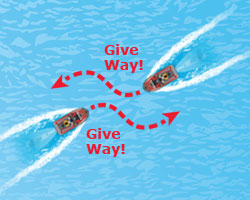PWC Encountering PWC
It is extremely important that a PWC encountering another PWC follow the same navigation rules that apply to motorboats or any other power-driven vessel.
Most fatalities involving a PWC result from injuries caused by collisions and not from drowning.
- The operator and passengers ride on top of the PWC instead of down inside it. There are no hulls or other enclosures to provide protection from the impact of a collision.
- Due to the lack of protection, PWC collisions are more likely to be deadly for the operator and any passengers.
Note that the following illustrations are not drawn to scale. The boats are shown closer to each other than they should be when actually encountering another vessel on the water.
Meeting Head-On: Neither vessel is the stand-on vessel. Both vessels should turn to starboard (the right).

Paths That Cross: The vessel on the operator’s port (left) side is the give-way vessel. The vessel on the operator’s starboard (right) side is the stand-on vessel.

Overtaking: The vessel that is overtaking another vessel is the give-way vessel. The vessel being overtaken is the stand-on vessel.

